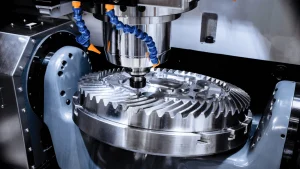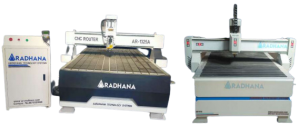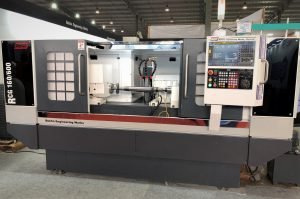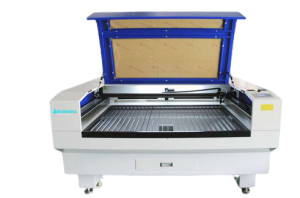CNC machine tool have many various types of tools for current-making. These machines are run by computer programs, which is very important for making precise, complex, and repeatable parts in many fields.
Some Widely Used CNC Machine Tools
CNC Milling Machine:
- Functionality: A CNC milling machine utilises rotary cutting tools to remove material from a workpiece, creating a desired shape or feature.
- Types: The spindle axis of a vertical milling machine is oriented vertically, while the spindle axis of a horizontal milling machine is oriented horizontally.
- Uses: Often used to make complex parts like gears, moulds, and engine parts in industries like automotive, aerospace, and general manufacturing.

CNC Lathe Machine:
- Functionality: CNC lathes rotate the workpiece while cutting tools are applied to it, however allowing for precise shaping and turning operations.
- kinds: There are different kinds, such as horizontal lathes, vertical lathes, and Swiss-style lathes, and each is best for a different job.
- Uses: Used to make cylinder-shaped parts like shafts, bushings, and fittings in fields ranging from medical device making to aircraft.

CNC Plasma Cutter:
- Functionality: CNC plasma cutters use a high-speed jet of ionised gas to cut through materials that carry electricity, like copper, steel, and aluminium.
- Kinds: Available in various forms, including small, portable, and industrial-grade CNC plasma cutting machines.
- Uses: Often used in the metal manufacturing, signs, and car industries to cut out complex forms and patterns.

CNC Router:
- Functionality: CNC routers use a spinning cutting tool to take material from a piece of work. They are most often used for tasks like etching, cutting, and shaping.
- Kinds: Available in three-axis, four-axis, and five-axis versions, giving different degrees of freedom for making complicated shapes.
- Uses: Widely used in woodworking, cabinetry, signage, and prototyping industries for producing intricate designs on materials like wood, plastic, and composite materials.

CNC Grinding Machine:
- Functionality: CNC grinders use abrasives to remove material from the surface of an item so that it has exact dimensions and a smooth finish.
- Types: Common types are surface grinders, cylinder grinders, and tool and cutter grinders. Each is designed for a specific job.
- Uses: Essential in tools and die-making, precision engineering, and aircraft for grinding components with tight tolerances and complex forms.

CNC Laser Cutter:
- Functionality: CNC laser cutters use a strong laser beam to cut through metal, plastic, wood, and cloth exactly.
- Types: Common types include fibre lasers, CO2 lasers, and diode lasers. Each works best with a different kind of material and a different thickness.
- Uses: It is used in many fields to quickly and accurately make complex designs, samples, and production parts.

CNC EDM Machine (Electrical Discharge Machining):
- Functionality: These machines use electrical discharges from workpieces so as to erode the material.
- Types: The two important types namely, wire EDM and sinker EDM. In the wire EDM, a thin wire of an electrode is there, and in sinker EDM, the shape of an electrode is a metal piece.
- Uses: Critical in tool and die making, manufacturing of mold, and aerospace for producing complex structures from hard materials with micron-level accuracy.

CNC Boring Machine:
- Functionality: They very precisely make the new holes or even the existing ones are enlarged. These are usually used to work on big pieces of metal.
- Types: The two popular types are Horizontal and vertical boring mills. Every single can be handled by a variety of product sizes and shapes.
- Uses: In the field, the important are oil and gas, building, and making heavy tools for cutting big parts like engine blocks, cylinders, and structure elements.
Functionalities of CNC machine tool
The below analysis will examine the functionalities of CNC machine tool names and the rationales that underpin their designations.
Frequent CNC Cutting Equipment
- Phasing Bits: Drill bits, the unsuspecting heroes, produce accurate apertures in a variety of materials. Their nomenclature frequently mirrors their form and function:
- Twist Drill: The most prevalent variety, the twist drill has a helical groove (twist) that aids in particulate evacuation and bit cooling.
- Centre Drill: Before continuing drilling, it creates a conical indentation to ensure precise positioning.
- Ejector Drill: Designed for deep cavities, ejector drill bits feature internal channels for efficient chip removal.
- End mills: They are adaptable workhorses utilised in a wide range of applications.
- Flat-end mill: It is an indispensable instrument for fabricating niches and flat surfaces; it has a flat cutting edge at the base.
- Ball Nose End Mill: Equipped with a circular cutting edge at the apex, this device is ideal for curved surfaces and contours.
- Bull Nose End Mill: Designed for roughing and filleting operations, this device features a combination of convex and flat edges.
- The Ball Nose Corner Radius End Mill: It combines a cylindrical shank and a ball nose to facilitate the manufacturing of precise radii and flat bottoms.
- Face Mills: Designed for rapid material removal across large flat areas, these tools have multiple cutting edges on the periphery:
- Square end face mill: The square cutting facets of the square end face mill facilitate rapid material removal.
- Ball Nose Face Mill: It combines the machining of the planar surface with the creation of contoured outlines around the perimeter.

Reaming, Threading, and Beyond Specialized CNC Tools
- Reamers: It serve to improve the precision and surface quality of pre-drilled holes by marginally enlarging the diameter. Their names often indicate their shank type (straight or taper) and the number of flutes.
- Gear cutters: They are specialised instruments designed to produce gear profiles. Their names are determined by the pressure angle and gear type (spur, helical, bevel).
- Hollow Mills: These tools have the central flute which resembles the inverted end mills.
- Thread mills: Both internal and external threads are produced at a single point with the help of cutting instruments. Their nomenclature may denote the thread standard (e.g., metric, inch).
- Slab Mills: By utilising many cutting edges on the side, to remove material rapidly from large, flat surfaces slab mills are high-productivity machines designed.
- Fly cutters: To utilise to create the face large or grooves they are rotating arbor-mounted single-point cutting instruments.
Common Used Terminologies
The names of CNC machine tools give clues on their function and design which often follow a logical structure. Here’s a breakdown of the common naming conventions:
- Function: Frequently, the initial descriptor (e.g., drill bit, end mill, face mill) designates the primary function.
- Geometry: The overall tool geometry or the shape of the cutting edge (e.g., square, flat, ball nose) is significant.
- Application: Sometimes, the name alludes to the specific application (e.g., thread mill, gear cutter).
- Material: Although uncommon, certain tools can be designated with their intend of material as their name.
- Shank Type: The method by which the tool is affixed to the machine may be specified (e.g., straight shank, taper shank).
- Number of Flutes: The number of cutting facets on the tool periphery can be an element of the name (e.g., two-flute end mill).
Variations Based on Brands
As the core functionalities define the general category of a CNC tool, manufacturers often introduce their variations and branding. These variations might involve:
- Unique geometries: These are characteristics or forms that are proprietary and designed to enhance performance or cater to particular applications.
- Trademarked names: Catchy names to distinguish their products from competitors.
- Material designations: Specific grades of carbide or coatings used in the tool.
Conclusion
In conclusion, CNC machine tools play the role of a pivotal role in modern manufacturing, enabling the production of precise and complex parts across various industries. These skills help make modern manufacturing processes more efficient, accurate, and flexible.







